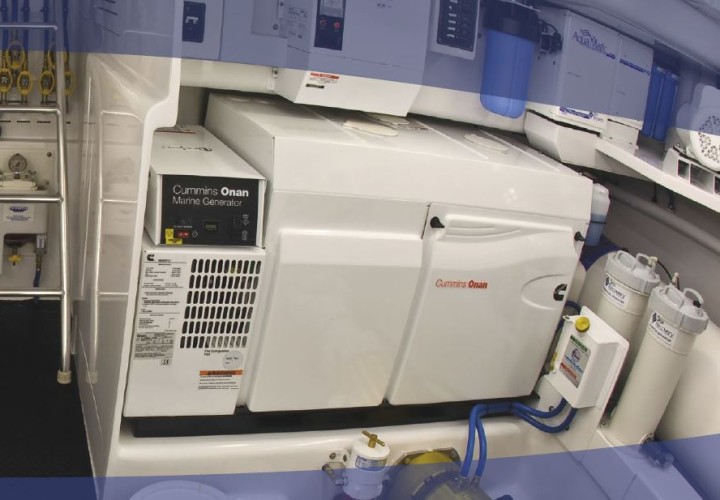After the main engine, the most expensive single piece of equipment aboard is often the generator, AKA marine genset. Moreover, a marine genset can log two or three times as many hours as your main engine(s), so choosing the right one is an important decision. You’ll want a generator that’s reliable, offers longevity, and delivers a comfortable time on board.
Choosing the right marine genset can be easy if you work with a generator dealer and analyse your requirements carefully. This buyer’s guide to choosing the right generator will familiarize you with a few terms and help you acquire a basic understanding of the different types of generators and how they operate.
AC or DC
The choice is really dependent on your application. If you primarily have a battery charging application then a lot of people put small generators in just to charge batteries, so you have to go ionto a mains powered battery charger and then to the batteries. If you go to a specifically designed DC charging battery generator the efficiency will be higher, the size and weight will be smaller and you pick up the advantage of a variable speed generator.
A lot of the earlier DC generators where simply a diesel or petrol engine with an automotive alternator, which by today’s standards was inefficient and noisy. New technology has seen the development of alternators that are highly efficient.
Inverter or Generator?
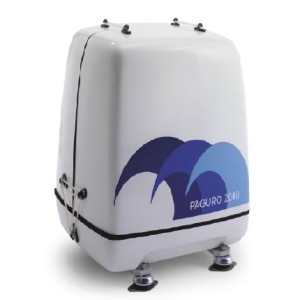
Inverters change DC electricity from your battery bank into AC power to run your AC equipment. Inverters work well for vessels that have relatively low power demand (1000-3500 watts) for short time periods. Boats with larger, consistent power demands and electric motors require a generator or both generator and inverter.
Engine, Hydraulic Drive, or Both?
Powered by a hydraulic pump on the main engine, hydraulic drive generators are best suited to boats with small, intermittent power requirements or long range cruisers. Generally, it is best to rely on a hydraulic generator when only small amounts of power are necessary because operating the main engine for electricity alone is inefficient.
Operating Speed Of Marine Gensets
Electronic equipment is designed to consume electrical energy with a fixed frequency. The international (SI) unit for frequency is hertz, symbol Hz, which is equal to one cycle per second. The United States and Canada use 60Hz power. Europe, Australia, and most Asian countries and New Zealand use 50Hz.
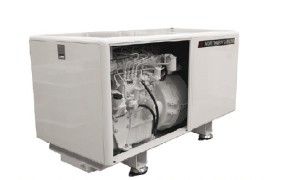
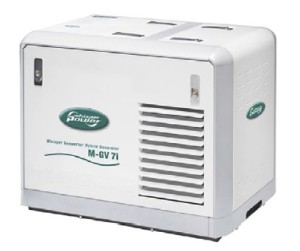
Choose the frequency used in the region where you will use your boat most. The frequency output of a generator depends on its fixed engine speed, unless you go to the new variable speed generators. To produce 60Hz electricity, the engine operates normally at 1800, or 3600 rpm (rotations per minute). 50Hz gensets run at around 1500, or 3000 rpm. Four-pole generators, running at 1800 rpm for US power standards or 1500 rpm for European standards, are most common. They offer great benefits – they are extremely fuel efficient, quiet, inexpensive, and dependable for the long haul. Two-pole generators are small and light, but these engines run at twice the speed of four-pole generators, which increases noise and decreases engine life.
However a modern 3000 rpm engine is very fuel efficient and comes with a long life span. They are significantly smaller and lighter than 1500 rpm generators and while the engine life is probably a little shorter the chances of doing enough engine hours to wear one out is unlikely. The average genset hours on a cruising boat is probably around 100-150 hours a year and the typical life of a modern 2-3 cylinder high speed diesel is probably between 3000-4000 hours. With a proper sound capsule and engine isolation mounts, it will be as quiet and smooth as a 1500 rpm unit.
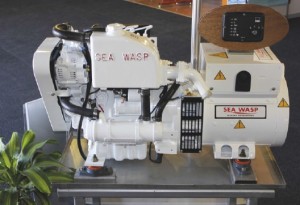
Petrol or Diesel Marine Genset?
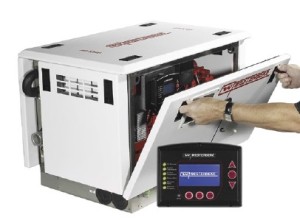
You’ll need to decide whether to buy a petrol or a diesel generator. If your main engine is a diesel, your genset should be, too. Keep in mind that the explosive nature of gasoline requires a spark-free generator, and therefore a diesel genset is a safer bet for a petrol main engine as well.
Cooling Systems
Liquid cooled generator engines are engineered to be used in a marine environment, and they are available in three configurations: heat exchanger, keel cooled, or direct seawater. Your generator should have the same type of liquid cooling as your main engine.
Marine gensets that are heat exchanger cooled feature two cooling water circuits. The “seawater cooling circuit” includes a rubber impeller or centrifugal pump that moves water from outside the boat, through a heat exchanger, and back overboard, often through the exhaust elbow. The “jacket water (also called freshwater) circuit” has a circulation pump that moves a coolant mixture continuously through the engine block and exhaust manifold (where it cools them) and heat exchanger, where it is cooled by the seawater.
Keel cooled generators have only the jacket water circuit. A circulation pump moves the coolant through a cooling grid on the bottom of the boat. Keel cooled generators require their own keel cooler so they are not tied to the main engine’s grid.
Engine Type
Marine gensets with in-line 4-stroke engines, whether diesel or petrol, are easy to install and service. Since four-pole generators operate at low rpms, the engine needs to produce its maximum torque near or below the operating speed. Automotive engines produce maximum torque at higher speeds. For example, when they run at 1800 rpm, almost all automotive engines are working at a point below peak torque, which will limit the engine’s ability to pick up extra loads such as watermakers, air conditioners, or refrigerators. Engines that are made for heavy-duty, industrial applications offer you strong, reliable low-end torque and provide the power to pick up supplementary electrical loads, even when running at full power. The penalty of course is extra size and weight, which can be quite significant.
If you are looking to produce under 10 kW with a 3000 rpm engine then you are still able to run a 2-3 cylinder unit, while if you are wanting the same from 1500rpm the requirements are generally for a four cylinder engine. As engine technology has developed in recent years, the negatives against high rpm small diesel engines has certainly been diminished.
Engine Benefits
- Cast-iron, liquid cooled exhaust manifolds increase safety. Dry manifolds can be a fire hazard. If there is a turbocharger, make sure it’s liquid cooled.
- All service points should be gathered on one side for easy maintenance. This also allows the non-service side of the generator to be installed directly against a bulkhead to save space in the engine room.
- On larger machines, choose one with liquid cooled, replaceable cylinder liners. This will dramatically lower rebuild costs. If it’s a smaller high rpm diesel it may be cheaper to simply replace the engine.
- You will also benefit from having safety shutdowns for high water temperature and low oil pressure on your next generator.
- L ook for a design that eliminates unnecessary, troublesome equipment such as hoses, belts, and gaskets.
Single-Phase or Three-Phase?
Marine gensets produce either single-phase or three-phase power. Three-phase motors are less expensive than singlephase motors. And while three-phase power is better for motor starting and running, 20kW generators and smaller usually feature single-phase motors.
Variable Speed Marine Gensets
Until recent times fixed RPM generators have been the only technology available. Regardless of whether they are low speed (1500/1800rpm) or high speed (3000/3600rpm) they have the same drawback. That is, the engine can only deliver the power available at one particular rpm. In the case of the low speed generators this results in a large engine being required to develop relatively small amounts of power. In the case of the high speed generators the compromise is on engine noise and engine life, although in reality neither is an issue on some models.
An ideal scenario is for the engine to be able to adjust its rpm to match the load power required at any given time. This is not possible on conventional systems where the frequency is related to engine speed. Hence a more sophisticated approach is required.
This involves generating a high frequency (nominally 400Hz) at a high voltage (nominally 270VAC) and then converting this via some solid state rectifiers into a high voltage DC power source. This DC power is now fed to a DC to AC inverter which has a fixed output of 230VAC at 50HZ. Since the actual AC output of the generator winding is converted to a DC the engine rpm can now varied without affecting the inverter output frequency and the engine now only works at a speed sufficient to supply a given load requirement.
The advantages are a large reduction in overall generator size and weight (high frequency generator windings are much smaller than lower frequency(50Hz) windings). A lower powered engine is also possible since for peak loads the engine can be operated at higher rpm. Also since the loads are often significantly less than the maximum power rating of the engine, the engine can be slowed down to an appropriate speed to deliver the lesser amount of energy without altering the output frequency of the inverter. Engine life is increased, noise levels decreased, and fuel economy optimised.
Advances in power electronics have made the whole conversion process highly efficient with the entire system having efficiencies over 90% A further adaptation of the technology can be used for DC battery charging generators. These provide a quiet and energy efficient method for battery charging and find frequent application in cruising boats where the prime requirement of a generator is battery charging.
The Right Size Marine Genset
Selecting the right size generator for your vessel is critical. If it is too small, it will wear out quickly, produce excessive exhaust smoke, and potentially damage electrical equipment. If it is too large, it will run under-loaded, lead to carbon build-up in the combustion chamber, leave unburned fuel in the exhaust, and operate inefficiently. A generator should never run continually with less than a 25% load. 35% to 70% is optimal.
Two generators may be the best answer for boats with varying power requirements. You can use a higher kW generator for high demand periods and a lower kW generator for times when power demand is minimal. Another option is to use a medium size generator that runs singularly or together with paralleling switch-gear or a simple split bus distribution panel.
It is best to have your generator dealer perform a load analysis of your vessel to determine what size generator you require. Your dealer will need the wattage requirement listed. Use this formula to calculate wattage: amps x volts = watts. Turning on appliances that utilise electric motors produces a current inrush, which can cause voltage and frequency dips and lights to dim. Depending on the quality and size of the motor being started, the amount of power necessary to start the electric appliance can be up to ten times its running wattage. This is why it is so important to supply your dealer with both the starting and running wattages of each motor. Your dealer can calculate the electrical load of all the equipment you will run at one time.
Accessories
Once you have determined the generator size, make a list of the optional equipment you will add to your boat. Front PTO (power take off) is a great way to take mechanical power off the front of the engine. Front PTOs are engaged with an electric clutch. Pump-mount PTOs can have hydraulic pumps attached to run hydraulics, deck machinery, and bow thrusters.
To reduce engine noise and increase on-board comfort, sound enclosures come optional with many generators. Some sound enclosures make accessing the generator more difficult, so when you choose a sound enclosure, make sure it features panels that are easy to remove. It is recommended to use circuit breakers to protect the generator from short circuits. Mount the circuit breakers as close as possible to the generator.
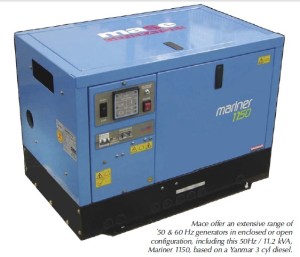
See Your Dealer
Once you have selected your generator and your options, take your shopping list to an established marine generator dealer.
It pays to get independent advice as each supplier will have a slightly different take on what works and what will best suit you. With your knowledge of your boat and their generator expertise, your boat will have a great power system that will give you years of reliability.
Special thanks to Northern Lights and Enertec for the basis of this article. For more, go to www.northern-lights.com or www.enertec.co.nz


